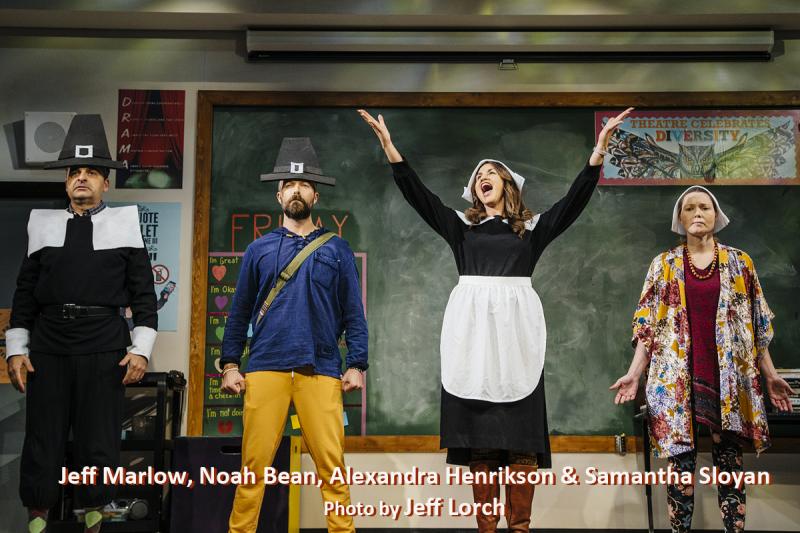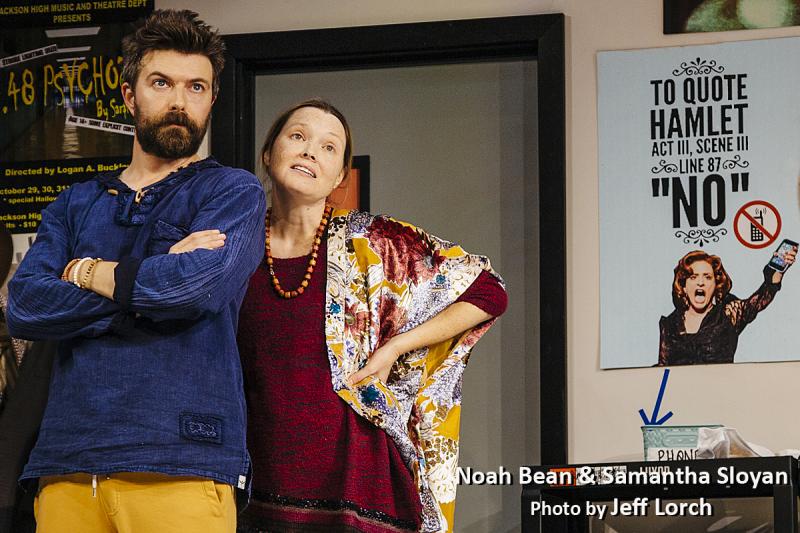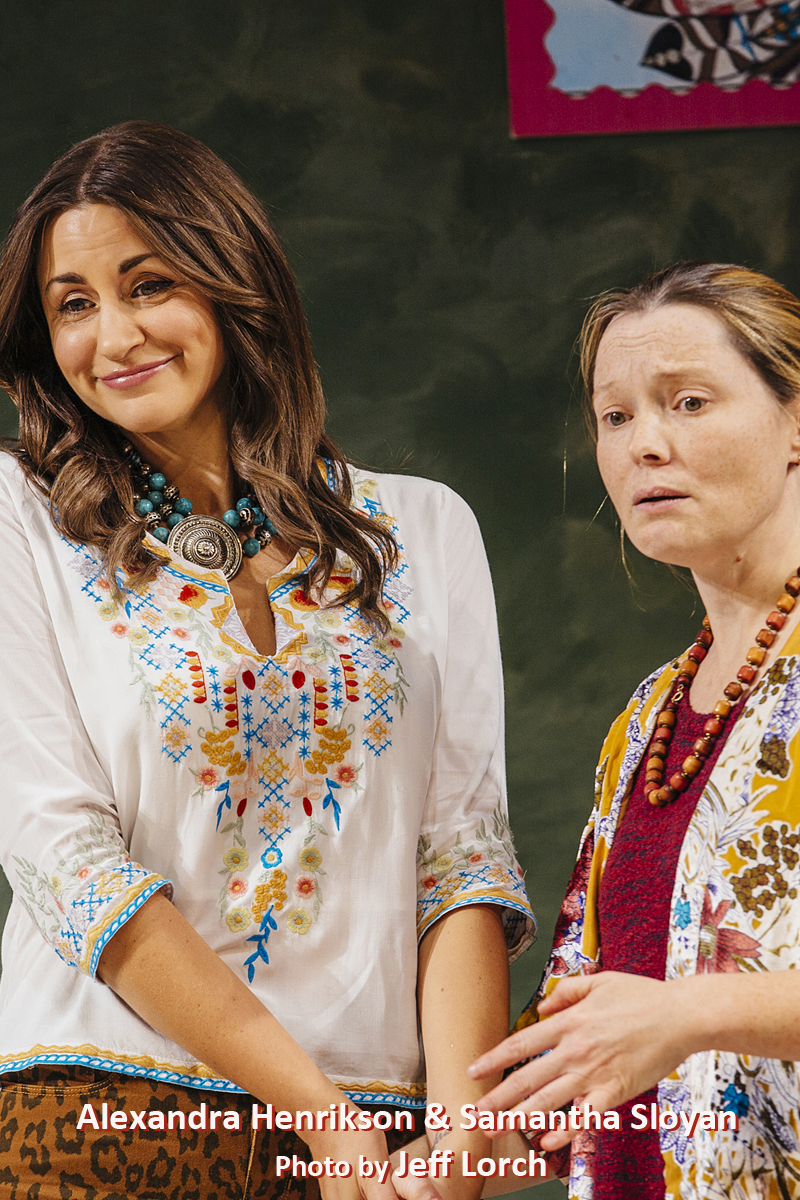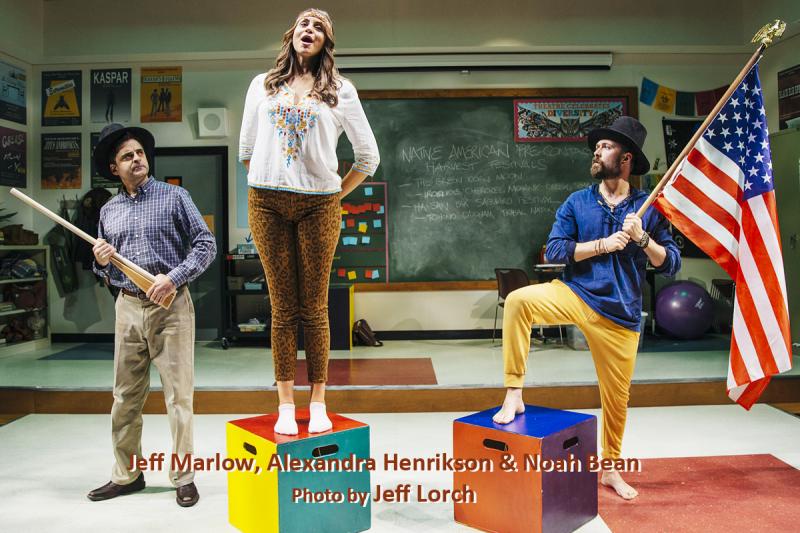Interview: Indigenous Playwright Larissa FastHorse Setting The Table With Truths In THE THANKSGIVING PLAY

Playwright Larissa Fasthorse is having one hell of a year. Her THE THANKSGIVING PLAY has already been produced in various cities across the United States this year, with her next production already in previews at The Geffen Playhouse, and opening November 5, 2019. Michael John Garcés directs Larissa's humorous and woke take on Thanksgiving traditions featuring Noah Bean, Alexandra Henrikson, Jeff Marlow and Samantha Sloyan.
After a full day of PLAY's rehearsals, I had the opportunity to chat with Larissa on her South Dakota, Sicangu-Lakota heritage.
Thank you for taking the time for this interview, Larissa! How's rehearsals going?
Good. I was actually standing in for Michael (John Garcés) today. He's casting another show he's doing. So he's going from one theatre to another.
THE THANKSGIVING PLAY began with a fellowship from the Guthrie Theater in 2016. Was it your idea to pick Thanksgiving as the topic?
Yes, all of that was my idea. It was very much open to 'write anything you want to write.' I wanted to do something what was sharp enough for Native People, but at the same time was universal for everybody else.
Any particular incident sparked the creation of THE THANKSGIVING PLAY?
Yeah, every day of my life! Funny, because American theatre, as a whole, has been so lovely in embracing this play and making it one of the most produced plays in the country. It was really my frustration with American theatre, and not being able to say the things I wanted to say, and the way I wanted to say them, and having people be so well-meaning and so tactful to the point that nothing happened. From all of that and the frustration and the well-meaningness in my daily experiences that I came up with the play.
What would your three-line pitch of THE THANKSGIVING PLAY be for a prospective producer?
 Well, if I was talking professionally, I'd say it's a play about four well-meaning white people trying to devise a politically correct play for Thanksgiving and Native American heritage. If I'm talking to a person of color, I'd say it's me making fun of white people for ninety minutes. So, those are the two pitches.
Well, if I was talking professionally, I'd say it's a play about four well-meaning white people trying to devise a politically correct play for Thanksgiving and Native American heritage. If I'm talking to a person of color, I'd say it's me making fun of white people for ninety minutes. So, those are the two pitches.
You grew up in South Dakota. At what point did you start to question the traditions of celebrating Thanksgiving? Did your family observe Thanksgiving at all?
My family does observe Thanksgiving. Simply much more about just gratitude and family time and being together. We never talk about pilgrims or Indians or anything like that. More about a day to be grateful, which is an awesome thing to just stop and feel that for a whole day. However, as far as the whole history of it, we're super aware of the difficulties and complexities of it, and what I've learned since writing this play is the outright lies about that holiday and what it means.
At what age did you consider yourself 'woke?'
I don't think I am woke. Most of my friends would say that I am one of the most inappropriate people you're ever going to meet. So I don't get to be woke. As far as awareness, it's just something that can't avoided as an Indigenous woman living in this country, living on stolen land at all times; and the continued, intentional erasure of our people. That's just something that is always there. There's no escaping it. That's something that we have to deal with on a daily basis.
Did you learn all this at home? At school?
 I'm adopted. My parents are white. They were really concerned at making sure I was connected to my Lakota culture. They brought in folks to be mentors and examples for me. A lot of it, in my school at the time. I went to school during the time of reconciliation in South Dakota when the state was trying to reconcile with the Lakota nation who were in the state. So there was a lot of positive education around Indigenous people, around relationships between the state and the sovereign nation within the state. We also never celebrated Columbus Day, or celebrated Thanksgiving with pilgrims and Indians. It was always more of a harvest festival, which made sense in a place which had so much agriculture. And obviously, it's a life-long learning, as well, which I continue. We're always making mistakes. We made mistakes with this very play here at the Geffen. We had a terrible error in the original design for the poster art. We had no idea what we were stumbling into. There was a Massachusetts state highway sign with a pilgrim's hat with an arrow shot through it, but in a negative way. It was very offensive to Indigenous people and creating a lot of derision in Massachusetts. There was a campaign a while ago to get rid of it. It was a very difficult and emotional campaign for people and they succeeded. But then, without even realizing it, we stumbled right into being characters in the play and creating the original art that had a Thanksgiving hat with arrows through it. We've since removed that image. It's kind of hilarious, life imitating art. The best meaning people, including a Native American woman. There are friends that realize that, 'Let's embrace this. Let's talk about it. Let's take this as a chance to educate.' There's a blog post to tell about the whole process of it.
I'm adopted. My parents are white. They were really concerned at making sure I was connected to my Lakota culture. They brought in folks to be mentors and examples for me. A lot of it, in my school at the time. I went to school during the time of reconciliation in South Dakota when the state was trying to reconcile with the Lakota nation who were in the state. So there was a lot of positive education around Indigenous people, around relationships between the state and the sovereign nation within the state. We also never celebrated Columbus Day, or celebrated Thanksgiving with pilgrims and Indians. It was always more of a harvest festival, which made sense in a place which had so much agriculture. And obviously, it's a life-long learning, as well, which I continue. We're always making mistakes. We made mistakes with this very play here at the Geffen. We had a terrible error in the original design for the poster art. We had no idea what we were stumbling into. There was a Massachusetts state highway sign with a pilgrim's hat with an arrow shot through it, but in a negative way. It was very offensive to Indigenous people and creating a lot of derision in Massachusetts. There was a campaign a while ago to get rid of it. It was a very difficult and emotional campaign for people and they succeeded. But then, without even realizing it, we stumbled right into being characters in the play and creating the original art that had a Thanksgiving hat with arrows through it. We've since removed that image. It's kind of hilarious, life imitating art. The best meaning people, including a Native American woman. There are friends that realize that, 'Let's embrace this. Let's talk about it. Let's take this as a chance to educate.' There's a blog post to tell about the whole process of it.
Has your script changed any since your reading at DC's Center Stage Play Lab? Since Oregon's Artists Repertory Theatre April 2018? Or since your off-Broadway production last October by Playwrights Horizons?
Yup. A lot. This play has been very popular from the beginning. When I got the finishing commission from Artist Repertory Theatre in Portland, Oregon; it was barely even a draft, 45 pages, hardly an idea. It's been very popular. Before the first production, we had a lot of readings. This year, including student productions, I think we're up to seventeen productions around the country.
Have you ever worked with any of the Geffen cast or crew before?
No, I have not worked here before, even though I've been living in Santa Monica for a long time. I go to so many shows here. I always love the productions here at the Geffen. They do such a beautiful job. But I'm now also working with them, commissioned to write a new musical with Mizer and Moore. A reimagining of a musical that talks about history and truth and, what do they call the news? Fake news. We'll interrogate history, interrogate who's telling the story and what point of view is telling the story. How stories change through history depending on the point of view and the political advantage of telling it different ways.
 I'm Asian, I grew up seeing Caucasian women dressing up in Chinese cheongsam and thought nothing of it. In college, I had a lady friend who was black who custom-made a dashiki for me to wear. Today, I would have second thoughts before wearing a dashiki, or an Indian headdress. What's your take on wearing traditional outfits of ethnicities not of their own?
I'm Asian, I grew up seeing Caucasian women dressing up in Chinese cheongsam and thought nothing of it. In college, I had a lady friend who was black who custom-made a dashiki for me to wear. Today, I would have second thoughts before wearing a dashiki, or an Indian headdress. What's your take on wearing traditional outfits of ethnicities not of their own?
It really depends on the people, right? For instance, in Native American cultures, wearing a headdress is not ok. That's something that's very culturally and fiercely significant that is earned through a long and difficult process. You earn those feathers and the right to wear them. That's something very spiritually specific. However, I have a friend from India who wants me to wear a sari with her. I was really concerned about that. I don't think that would go over well.
She said, 'Look, a sari is the one thing that all women in India wear. Doesn't matter if you're Muslim or Christian or Hindu, whatever you are. Any women of any class can wear a sari. You cannot let anyone take the right to wear a sari away from you as a woman. That's your right.'
Well, I can't argue with that. I haven't actually worn it yet. We're going to go shopping. It's really interesting to have a different point of view from someone who is from that country. I know that when I wear it and I'm not with her, I will receive some really difficult reactions and I'm willing to take them in honor of my friend, who wants to honor me with something she believes every woman has a right to. A sari is not spiritual in any way. It's clothing that anyone can wear.
Whereas the headdress has a spiritual connotation.
It does. So depends on what the thing is. I'm opposed to anyone wearing anything, to be like a costume, to put on another culture as decoration. That's a tricky line, right? You're putting on something for Halloween making yourself into someone else or objectifying them with, let's say, a sexy Native costume or something. Then, that's not ok. Creating humans as others and as objects you can put on and take off . But if you're talking about wearing something that is culturally specific that you're been told from someone in that culture that it's alright for you to wear, wear that. We get down on people to where we shouldn't wear anything Native American. No, if you bought something from a Native American artist, wear it. Support those artists. If they're selling it, it's something for you to wear. They wouldn't sell you something you shouldn't be wearing. You should not be going to Urban Outfitter and buying a Navajo-style something that is not benefiting Indigenous partners.
 What current projects is Indigenous Directions that you co-founded with Ty Defoe involved with?
What current projects is Indigenous Directions that you co-founded with Ty Defoe involved with?
Our consulting company. We consult with companies that want to engage with Indigenous art audiences and artists. We are currently working with Roundabout Theatre Company in New York City, helping them to develop a strategic plan for how they want to acknowledge and work better with Indigenous populations. We're also working with Western Arts Alliance on a large international program to encourage touring of Indigenous performance pieces. We're working with the Guthrie Theatre raising money for our third project with them right now. It's really wonderful that American theatre is putting their money where their mouth is and putting together plans and strategies to work with Indigenous people, and trying hard to make that change, and give back some of which they owe being on Indigenous lands.
Where did the term 'Indigenous' originate from?
I can't tell you. I don't know. The reason I use the word 'Indigenous' when I'm talking in generalities is because I don't want to acknowledge the current political border between the United States and Mexico and Canada. At one time, this was all one land of Indigenous people who traded and supported each other, travelled to each other's land. I really like to continue to honor that decent exchange that's been going on for long before the United States in America exist. If you say Native American, that does leaves out those people not specific Native Americans. They're talking about policies specific only to the current country. I would call myself Sicangu-Lakota because that's the nation that I'm a member of.
Would you call yourself Native American or Indigenous?
Yes, I'm all those things. Just different levels like macro to micro.
As part of your production contract, there must be at least one Indigenous artist in your shows and one other Indigenous artist's work in the theatre. Who did The Geffen Playhouse include for THE THANKSGIVING PLAY?
You know what? This is actually a weird first experience for me. This play is being licensed through Samuel French. This is the first time that happens for me that I do not actually have a contract with the Geffen, because they're licensing the play. However, they're gone ahead on their own. They're doing a lot of work with Indigenous committees promoting local Indigenous People's Day coming up, having different special guests and talks and promotions. They also have been very graciously allowing me to be a part of the entire process, even though contractually, they don't have to. As far as running things like design and different things by me, they've been really fantastic and making sure that I have final say over things. They honestly don't have to now they're licensing through Samuel French. And, of course, I'm also a commissioned artist now, That'll be different. They'll produce my musical.
 Do you find that you write to entertain? Or to educate? Or both?
Do you find that you write to entertain? Or to educate? Or both?
I'm an artist. My first mentor was a woman named Mereta Mita, who's a Māori woman, a filmmaker in New Zealand. She was my writing mentor. And she said be honest. Larissa, you can either you be an educator or be an artist. You try to do both, you're going to do both badly. Some art does educates and some education is artistic, but you have to chose which one you want to be. I chose artist. I am an artist. It just so happens that a lot of my work educates because our American educational system does a horrible job of educating Indigenous populations. So anything is education for most of my audiences, but that's not my goal. My goal is being an artist. To create art and beautiful communal experiences that are sometimes incredibly uncomfortable, and sometimes incredibly entertaining.
What forces of nature urged you to become a delegate of the United Nations in 2000?
I was modeling in a fashion show here in Los Angeles. I was asked to go do that. It was very weird. It was for a Indigenous fashion designer. I was asked to go and ended up being a speaker. I ended up actually speaking on more things than I was originally supposed to be speaking on. That was when I started my writing career, which was in film and television. Then later I transitioned to theatre. That was a pretty incredible opportunity and experience to be able to speak there.
What's in the near future for Larissa Fasthorse? I think we're covered a few already.
Oh, my goodness! So many things. I'm really fortunate that my theatre career is going well. THE THANKSGIVING PLAY is going all over the nation this year. I'm taking a year off of new productions to write for a year. I'm commissioned with a lot of theatre companies all over the nation that I'm working on. I also have a TV series set up in a network, a TV movie and I'm working on another TV series we're about to set up as well, so I have plenty to write.
With what emotions would you like the Geffen audiences to leave with after THE THANKSGIVING PLAY's curtain call?
Curiosity. I want people to be curious, and to want to know more. To have to find some things out, and find out why they felt the way they felt, and why things are funny, and why things weren't funny, and why they don't know these things. And what they can do to make that difference
It should be a lot of fun. People laugh a lot, but they also think.
Thank you again, Larissa! I can't wait to see how you make fun of four white people!
For ticket availability and show schedule through December 6, 2019; log onto www.geffenplayhouse.org
Comments
.png)
|
.png)
|
Videos

